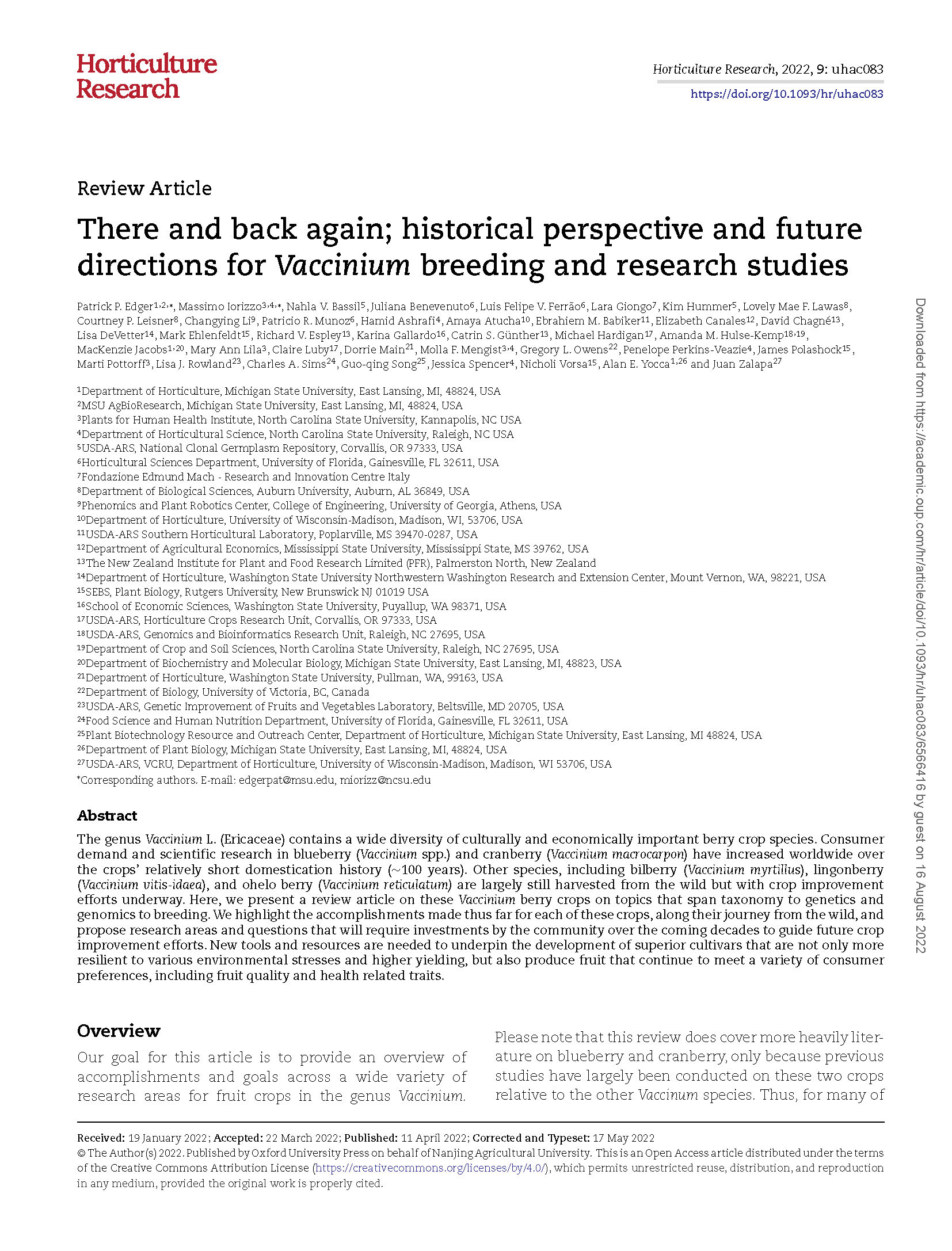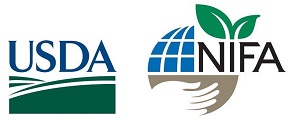The genus Vaccinium contains a wide diversity of culturally and economically important berry crop species, including blueberry and cranberry. Consumer demand and scientific research in both have increased globally over the crops’ relatively short domestication history (~100 years). Consumer and industry demand for more fruit with improved quality and health related traits continues to grow. New tools and resources are needed to develop superior cultivars that meet consumer preferences, and are more resilient to a changing environment. Over the years, there have been increasing accomplishments and goals across a wide variety of Vaccinium fruit crop research areas. But, more comparative studies in Vaccinium that include a wider diversity of wild and cultivated species are needed to meet those consumer and industry demands.

Breeding Priorities for Blueberry, Cranberry, and Related Crops
The main commercial Vaccinium crops are cranberry, lingonberry, and blueberries, which includes northern highbush blueberry, lowbush blueberry, and rabbiteye blueberry. Traditional blueberry and cranberry breeding methods are expensive and time-consuming, taking at least a decade to release new cultivars. Over the last thirty years, investments in blueberry breeding led to the development of new low-chill southern highbush cultivars and contributed to the massive expansion of production in many non-traditional areas worldwide. Other target breeding traits for blueberry improvement are:
- Yield
- Fruit quality (size, color, firmness, flavor)
- Vegetative characteristics (vigor, disease resistance, plant architecture to facilitate harvest mechanization)
- Adaptation (cold hardiness, self-fruitfulness, soil pH tolerance).
For cranberry, high but stable yields are a critical trait as many cultivars exhibit a biennial—every other year—bearing habit. Other priority traits for cranberry improvement are:
- Fruit quality (color, firmness, uniform large size for the sweetened dried cranberry market)
- Disease and pest resistance
- Vegetative characteristics (vigor, adaptation including heat, cold tolerance)
Breeding priorities across the North American blueberry and cranberry industries were assessed through a survey, conducted between 2016-2018, as part of a planning grant funded by USDA-NIFA, and served as a foundation to establish the Vaccinium Coordinated Agricultural Project (VacCAP).
Genomic, Transcriptomic, and Metabolomic Resources for Vaccinium
Blueberry cultivar development, while already seeing improvement, needs more publicly available genomic resources to meet increased consumer demand and preferences quicker. There has been significant development of marker-assisted breeding resources, but next-generation genomic, transcriptomic, and metabolomic resources are critical to guide the development of these markers.
The Genome Database for Vaccinium (GDV)— the crop community database for Vaccinium —provides access to integrated genomic, genetic, and breeding peer-reviewed published data, and analysis tools. The repository in GDV contains gene, genome, genetic map, marker, phenotype, publications, QTL, species, transcriptome, and trait data curated by the GDV team. Tools include a genetic map viewer, genome browser, synteny viewer, metabolite pathways browser, sequence retrieval, BLAST, and breeding information management system (BIMS). A suite of search tools provides intuitive querying of all major data types.
Additional Vaccinium genomic resources will soon be available through VacCAP. A cornerstone of VacCAP is developing a Vaccinium pangenome—a collection of genetic material present within a taxonomic group. Building a pangenome is necessary to identify and characterize all important genes in Vaccinium , and to develop markers to guide future breeding efforts.
Recent availability of high-quality reference genomes for Vaccinium and technological advances in RNA-sequencing have also advanced transcriptome profiling. Recent studies have focused on everything from the biosynthesis of metabolites with human health benefits to postharvest storage. Transcriptome and transcript expression data can also be found through GDV and future resources will be made available through VacCAP.
While databases for genome and transcriptome data are available, there is no comprehensive resource to access metabolic information specific to Vaccinium . However, several papers reporting metabolite composition of several Vaccinium species have been published. With the increasing use of metabolomic techniques, more studies on the metabolite composition of Vaccinium are expected. As depositing data in a metabolomics repository becomes a requirement for publishing, this will allow for more comprehensive metabolite resources to be available and easily accessible in the future. Species-specific differences could complicate data analysis for Vaccinium, so a source of Vaccinium metabolite data generated by a consortium of laboratories will be crucial for establishing metabolomics as a functional genetics tool.
Having publicly available comprehensive genomic, transcriptomic, metabolomic and proteomic datasets in addition to a community-based platform for connecting such data is essential to understanding how gene-metabolite networks determine specific traits. The recently established Paired Omics Data Platform is an initiative to help streamline access to paired genomic and metabolomic data from public databases and repositories.
Genetics of Fruit Quality and Related Target Traits
Fruit quality is subjective depending on your role in the production chain—a grower may value a different trait than a consumer. This discrepancy poses a challenge to modern blueberry and cranberry breeding programs, who now must balance the needs of all parties and release new cultivars that produce higher quality fruit without sacrificing the horticultural traits required by the industry. Researchers recently revised some blueberry quality standards established in the 1990’s and noticed that the rapid genetic progress has changed the standards for fruit quality.
Firmness has experienced the fastest breeding progress in blueberry. Firmness, an indicator of texture quality, is a desirable fruit quality trait for both growers and consumers. Firmness may reduce internal bruising during machine harvesting and delay postharvest decay. In a comprehensive review, Cappai et al. (2018) reported a large diversity in firmness between and within blueberry types and most importantly, a substantial improvement in modern cultivars compared to the first-released cultivars, indicative of intense breeding progress.
Blueberry fruit size is another trait that has experienced profound changes over time. A large variability among cultivars and wild species has been reported, and a significant association for firmness and size co-localized in both a QTL and genome-wide association (GWAS) study indicate good prospects for simultaneous selection for both traits. Sugar-acid balance is another trait of importance in blueberry flavor perception, as consumers prefer a sweeter berry, resulting in newer cultivars with reduced soluble solids/total titratable acidity ratios.
A recent consumer perception survey showed that consumers are most interested in fruit aspects related to flavor and human health attributes. A second group of metabolite traits have been explored at the breeding level, with the potential for flavor and nutritional improvements.
Besides the recent advances in blueberry and cranberry genetics, an understanding of the genetic mechanisms controlling various traits in blueberry and cranberry is still limited. Few QTLs have been validated across multiple studies and very few candidate genes have been identified. The increasing availability of genetic and genomic tools for Vaccinium crops will help fill in the gaps. Multiple genetic studies targeting several fruit characteristics such as harvest and postharvest studies to assess texture and storability, organic acids and metabolites are currently ongoing as part of VacCAP. Along with other projects, these efforts will establish a roadmap for a marker assisted breeding (MAB) strategy in Vaccinium crops.
Molecular Markers and High-Throughput Genotyping Platforms
Diverse tools and approaches have been used to guide breeding efforts in Vaccinium. Dominant markers were developed and used in blueberry and cranberry over the years. Simple sequence repeats (SSRs) were extensively used both to assess relatedness and genetic diversity, for cultivar identification, and linkage mapping. As Next Generation Sequencing (NGS) technologies were applied in Vaccinium, species-specific SSRs were developed and the era of high throughput genotyping and single nucleotide polymorphism (SNP) markers began in blueberry and cranberry.
There are two types of approaches to high throughput genotyping, targeted and non-targeted. Both approaches have been used in tetraploid cultivated blueberry (V. corymbosum), while only genotyping by sequencing (GBS), a non-targeted approach, has been used in cranberry.
GBS has been useful in both crops, used for the analysis of genetic diversity linkage mapping and QTL analysis. In cranberry, high-density linkage maps allowed the identification of many cranberry QTLs associated with traits like fruit shape and fruit color. However, GBS has limited application for polyploid Vaccinium such as highbush and rabbiteye blueberries as its sequencing read depth is often highly variable between loci and samples. Target capture’s read depths are more consistent between samples and loci. This allows for more correctly estimated allele dosage which helps in identifying SNPs associated with traits like fruit quality and cold hardiness. Target sequencing also has been used to genotype a diversity panel of 280 blueberry accessions and cultivars collected from the North Carolina State breeding program and National Clonal Germplasm Repository in Corvallis.
GBS and target capture require bioinformatics capability and reproducible workflows for data analysis. VacCAP’s goals to develop high-throughput genotyping platforms, improve of software, decrease sequencing costs, and create reproducible workflows are necessary in this endeavor. These will allow for faster MTA discovery, and enable genomic and marker-based selection that are all needed for the development of new superior cultivars.
Genome-Assisted Breeding in Vaccinium
Modern genomic tools have shown the potential to reshape current blueberry and cranberry breeding programs by allowing for more efficient selection, faster cultivar development, and assists in maintaining a genetically diverse breeding population. Genomic-assisted breeding has been bolstered by advancements and declining costs in sequencing technologies along with new methods for genomic data manipulation.
Linkage maps help with the detection of major QTLs in association analyses. Genetic linkage maps in blueberry have become continually more saturated and higher resolution by including more markers and recombinant individuals, respectively. A high degree of collinearity between blueberry and cranberry genetic maps indicates the potential for QTL and marker transferability between species. The objective of QTL mapping analyses is to identify marker-trait associations based on the inheritance of markers within a family-based mapping population. Identifying the genomic regions controlling important horticultural and fruit quality traits are important for marker-assisted selection. The first QTL mapping study focused on understanding the underlying genetics of cold hardiness and chilling requirement related traits in blueberry. In the years since, consistent QTLs were identified for fruit quality and machine harvest-related traits.
GWAS is a genomic tool for the identification of genetic variants associated with important traits. GWAS takes advantage of the linkage disequilibrium from historic recombination events accumulated over generations in a diverse panel of genotypes. Thereby, it provides higher resolution for the QTL mapped, makes use of greater allele numbers, detects more frequent QTLs in the population, and multiple traits can be assessed. GWAS analyses have been recently performed in southern highbush blueberry for fruit quality and yield-related traits, including flavor-related volatile compounds.
QTL mapping and GWAS studies are paving the way for the use of molecular markers to select superior genotypes. Marker-assisted selection is not being fully integrated into any public Vaccinium breeding program so far, but once significant markers explaining a large proportion of trait variability are identified, it can be used to inform breeding and selection decisions. Genomic selection is being implemented in select public and private blueberry breeding programs.
Gene and Gene Editing for High Precision Breeding
Traditional breeding of Vaccinium crops is a time-consuming and labor-intensive process. However, recent advances in Vaccinium genomics and gene editing technologies could be used to target desirable horticultural traits within the genomes of Vaccinium species.
Genetic engineering relies on the presence of suitable target genes and new biotechnological tools such as efficient transformation protocols and effective gene manipulation. Genetic engineering would greatly speed the introduction of individual genes of interest for precision breeding of desirable characteristics among existing cultivars. Stable transformation of both blueberry and cranberry has been made possible with the development of efficient regeneration protocols. Genetic transformation of cranberry has, to date, resulted in the development of transgenic cranberry for herbicide resistance. Transgenic blueberries have been developed for herbicide resistance, freezing tolerance, early flowering, yield increase, and gene knock-out.
Great efforts have been made to improve blueberry and cranberry using genetic engineering; however, no genetically modified Vaccinium crops have been released for commercialization. Currently, a lack of research funds from government and industry sources has slowed the application of genetic engineering for improvement of Vaccinium crops and consumer acceptance is unclear.

Conclusion
Over the last few years, the first high-quality chromosome-scale assemblies for blueberry, cranberry, and bilberry have been published and provided an excellent set of resources for understanding the underlying genetics of important target traits in Vaccinium fruit. Creating pangenomes for each crop will be instrumental in quantifying and dissecting the diversity present in wild populations and various breeding programs. Developing new genotyping tools and technologies in phenotyping will help accelerate genetic discoveries and advance breeding efforts. New tools and resources will pave the way for developing new cultivars that meet consumer and industry preferences. Data infrastructure, storage and analyses, and efforts to conserve wild germplasm around the world are also important. Genetic and phenotypically diverse wild populations could improve the resilience of Vaccinium crops and various fruit quality traits, particularly important in mitigating production issues related to global climate change.













